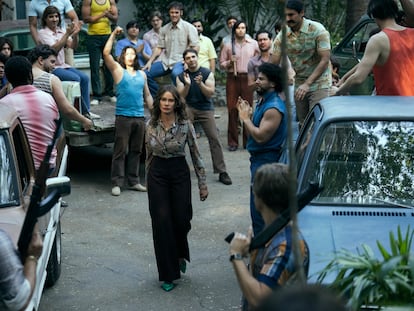Six great films that turn 50 in 2024 to watch on streaming
‘The Godfather, Part II,’ ‘Chinatown’ and ‘The Texas Chainsaw Massacre’ are some of the titles that saw the light in 1974, framed in the context of the New Hollywood

The year 1974 was marked by the magnificent level of American cinema. Since the style, boldness and themes of what would end up being known as New Hollywood first emerged in 1967, those were times of daring demystification, as three different generations developed films that were critical of the system, a reflection of their society, marked also by countless political conflicts. The young graduates of art and film schools were met by a series of veterans who had found a new territory of freedom, and by the directors of the generation of commitment, coming from television. This is how, in 1974, works by filmmakers such as Brian De Palma (Phantom of the Paradise), Martin Scorsese (Alice Doesn’t Live Here Anymore) and Steven Spielberg (Crazy Evasion) coexisted with those of Billy Wilder (The Front Page), Sam Peckinpah (Bring Me the Head of Alfredo García), Don Siegel (The Black Windmill) and Robert Altman (California Split), on one hand, and with those of Robert Mulligan (The Nickel Ride) and Sydney Pollack (The Yakuza) on the other.
In this article, purposely diverse in terms of genres, we focused on those films that are currently available to watch on streaming platforms, a criterion that, inevitably, left many relevant titles out.
Chinatown (Roman Polanski)
It is the time of Seabiscuit, the racehorse that became a symbol of hope for Americans during the Great Depression of the 1930s thanks to its unexpected triumphs. Los Angeles is dying of thirst, water is rationed, farmers are desperate, and in the middle of the drought, the head of the City Water Department dies by drowning in a dam. It’s hopeless. Robert Towne, as screenwriter, and Polanski, as director, gave new life to film noir with a harsh story of betrayal and self-destruction. Jack Nicholson, a cocky private detective who sticks his nose where he is not wanted — and ends with a knife cutting through it (with Polanski himself doing it in a cameo); Faye Dunaway, a femme fatale reminiscent of the divas of American silent cinema; and John Huston, this time in front of the camera, as the fierce patriarch with dark family secrets, wave the old banner of film noir, that of fatalism and inner demons. Chinatown is not a place; it is a state of decrepitude. A concrete jungle that kills you with thirst.
Available on Netflix and Paramount+.
The Godfather. Part II (Francis Ford Coppola)
The rise of Vito, the fall of Michael. Both of the same age. All in a single movie. More than the story of a family, the story of the origins of a country made up of immigrants: the roots, the drive, the hopes, the survival strategies. A double story of dreams and violence. After that door closed by Al Neri — Michael Corleone’s bodyguard — almost on Kay’s nose in the last, devastating shot of The Godfather, and especially after his well-deserved artistic and financial success, Coppola, pushed by Paramount and once more accompanied by Mario Puzo, achieved the difficult feat of outdoing the first installment with a sequel/prequel. The darkest of betrayals and the cruelest of family revenges. And from there, total darkness, the darkness in Michael’s heart. “Tom, you surprise me. If anything in this life is certain — if history has taught us anything — it’s that you can kill anybody.”
Available on Paramount+.
The Texas Chainsaw Massacre (Tobe Hooper)
Desecration, cannibalism and a social undertone: the new times that are destroying rural people. Hooper was a young teacher at the University of Austin and a documentary cameraman who all of a sudden redefined the horror genre with an atrocious low-budget film. His impossible frames, full of resentment and unhealthy intentions, begin to cause unrest, and the montage, as sharp, rough and cruel as Leatherface’s chainsaw, ends up destroying the viewer. Among the most unforgettable shots are the bloody green eyes of the proverbial final girl (the one survivor in a slasher film); the almost unbearable subjective shots around the table, which place you, as a spectator, on the verge of also being dismembered; and the eerie final dawn. It cost $140,000 to make and grossed $30 million in the U.S. alone. Its repulsiveness still works 50 years later, despite the myriad disciples, alternatives and copies that came after it.
Available on Peacock.
The Conversation (Francis Ford Coppola)
The sequel to The Godfather was not the only masterpiece Coppola made in 1974. There was also The Conversation, which caused his name to be repeated multiple times at the Oscars, where he had a nomination for Best Director (for The Godfather, Part II), two for Best Picture and two more for Best Screenplay — one original, one adapted. A total of 14 nods for both movies. The Conversation, a paranoid story about surveillance, as well as an existential work, is a film about the loneliness and the self-destruction of a man, an expert in illegal eavesdropping. It is also a film about the self-destruction of a country steeped in paranoia. It premiered in April 1974, in the midst of the Watergate scandal, and the president’s private recordings and tapes resonated perfectly with Gene Hackman’s character. As Bob Woodward of The Washington Post said, it was “a White House full of lies, chaos, distrust, speculation, self-protection, maneuver and counter-maneuver.”
Available on Netflix.
A Woman Under the Influence (John Cassavetes)
Cassavetes cannot be included in any trend. He was simply the creative father of many of them: of American independent cinema, of quiet bikers, wild bulls of the New Hollywood of the big studios, of anyone who wanted to grab a camera, put it a few inches from a face and capture its inner restlessness and its external excitement. At his side, his wife, the fantastic Gena Rowlands, and an entourage of talented artist friends who gave the impression of getting high with their way of making films. “I don’t think Mabel’s downfall is due to a social problem. The reasons must be sought in interpersonal relationships. Anyone who loves someone can drive them crazy,” said the director about his main character, a woman with mental problems tied to a husband who, considering the way he treats her, cannot be much saner. Originally written as a play, Rowlands begged Cassavetes not to present it on stage, because playing a role like that night after night would destroy her, physically and psychologically. The solution was to turn it into a groundbreaking film, which took them to the Academy Awards with nominations for Best Director and Best Actress.
Available on Max.
The Parallax View (Alan J. Pakula)
The Parallax Corporation is without a doubt a leading contender for the unofficial title of most unsettling company in the history of cinema. Its headquarters are located in an impersonal, gray, colossal building in Los Angeles, and they even conduct job interviews, but their operations are beyond any convention: accepting commissions to assassinate presidents, high-ranking political officials and anyone who may pose a threat to the established power. The American conspiracy craze of the 1970s, following the deaths of both Kennedys, Martin Luther King and Malcolm X, finds its cinematic champion in Pakula, also the director of the extraordinary films Klute and All the President’s Men. With Warren Beatty as the journalist who investigates the successive deaths of seven witnesses to the murder of a political candidate, and the ochre-toned photography of Gordon Willis, The Parallax View also possesses the highest quality of cinematic editing that can be offered, in the sequence where the protagonist is interviewed at Parallax about his killer instincts and his Americanism, and is confronted with a brutal juxtaposition of images with the concepts of love, mother, father, love, enemy and self. The culture of control and the game of fear.
Available on Netflix.
Sign up for our weekly newsletter to get more English-language news coverage from EL PAÍS USA Edition
Tu suscripción se está usando en otro dispositivo
¿Quieres añadir otro usuario a tu suscripción?
Si continúas leyendo en este dispositivo, no se podrá leer en el otro.
FlechaTu suscripción se está usando en otro dispositivo y solo puedes acceder a EL PAÍS desde un dispositivo a la vez.
Si quieres compartir tu cuenta, cambia tu suscripción a la modalidad Premium, así podrás añadir otro usuario. Cada uno accederá con su propia cuenta de email, lo que os permitirá personalizar vuestra experiencia en EL PAÍS.
¿Tienes una suscripción de empresa? Accede aquí para contratar más cuentas.
En el caso de no saber quién está usando tu cuenta, te recomendamos cambiar tu contraseña aquí.
Si decides continuar compartiendo tu cuenta, este mensaje se mostrará en tu dispositivo y en el de la otra persona que está usando tu cuenta de forma indefinida, afectando a tu experiencia de lectura. Puedes consultar aquí los términos y condiciones de la suscripción digital.
More information
Archived In
Últimas noticias
Most viewed
- Reinhard Genzel, Nobel laureate in physics: ‘One-minute videos will never give you the truth’
- Oona Chaplin: ‘I told James Cameron that I was living in a treehouse and starting a permaculture project with a friend’
- Pablo Escobar’s hippos: A serious environmental problem, 40 years on
- Why we lost the habit of sleeping in two segments and how that changed our sense of time
- Chevy Chase, the beloved comedian who was a monster off camera: ‘Not everyone hated him, just the people who’ve worked with him’











































